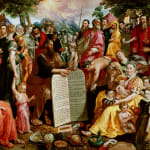
Maerten de Vos, Moses and the Tables of the Law, surrounded by Members of the Antwerp Panhuys and Hooftman Families.
Mauritshuis, The Hague, inv. no. 249.
Pieter Jansz Pourbus (Gouda 1523 - 1584 Bruges)
Pieter Jansz Pourbus was born in Gouda in 1523. Little is known of his early life, although it has been suggested he studied for some time in Leiden. At age 19 or 20 he moved to Bruges, where he joined the local guild of St Luke. Shortly afterwards he married Anne, the youngest daughter of the painter Lancelot Blondeel. In 1545/46 their son Frans ("the Elder", as he went on to have another Frans) was born; he later became a prominent artist in his own right. Initially, it appears Pourbus worked for Blondeel, possibly as his student. A number of works from his early years in Bruges were the result of a collaboration between Pourbus and Blondeel; sometimes however it is difficult to tell the two apart. Pourbus' early Allegory of True Love (now in the Wallace Collection, London, inv. P531) from ca. 1547 shows how truly innovative the artist was.
From 1549 onwards, Pourbus clearly became an independent painter, who was frequently given important commissions, such as the decorations for the Joyous Entry of Charles V and Philip II in 1549. Pourbus gradually became a popular portrait painter among the upper class, such as wine merchant Jan van Eyewerve and his wife Jacquemyne Buuck. In addition, Pourbus began to expressly date and sign his works in this period, indicative of the rise in his reputation and his growing artistic independence. Sources indicate that he also became much more active in the painter's guild. During this period Pourbus was also active as a cartographer, producing many topographic maps using a new method using triangulation, an innovativation that produced maps that were much more accurate.
Pourbus produced many portraits of nobility and wealthy merchants, in addition to altarpieces and epitaphs. He became a wealthy man, purchasing a large house and setting up a studio the art historian Karel van Mander - who met the artist in Bruges in 1580 - called one of the best he had ever seen. Pourbus taught his son and grandson (Frans I & II), in addition to others such as Antonius Claeissens. Stylistically he helped introduce the Italian Renaissance in the Low Countries, although his works are considered by some to be the last examples of the traditional Bruges school of painting. Pourbus was considered by both the Italian historian Guicciardini and the art historian Vasari as one of the leading painters of his day; van Mander, too, was impressed by the artist. Clearly his contemporaries thought highly of him.
Pourbus died in January 1584, leaving behind an impressive legacy as well as an important oeuvre. Our portrait, which shows the alderman and treasurer of the city of Antwerp Peeter van Panhuys (Limbourg 1529 - 1585 Amsterdam) at the age of 34, was painted when Pourbus was at the height of his powers. Depicted at half length, looking confidently towards the audience and dressed in a beautiful black outfit with a heavy gold chain, the young man is clearly aware of his status and importance. An important art collector in his day, he was also depicted twelve years later in Maerten de Vos' famous painting Moses and the Tables of the Law, surrounded by Members of the Antwerp Panhuys and Hooftman Families, now at the Mauritshuis Museum (inv. no. 249; see illustration - van Panhuys is standing second from the right).
Provenance
Belgian private collection.


